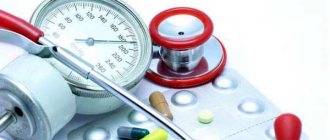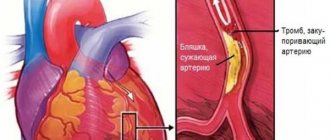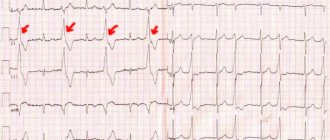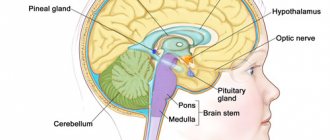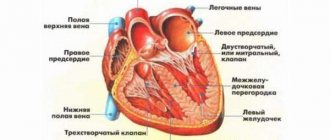Treatment
Treatment of stage 2 hypertension consists of drug therapy, proper nutrition and the use of traditional methods.
All these treatment tactics should be selected by a specialist and in no case should you self-medicate. Drug therapy includes groups of drugs:
- ACE inhibitors – Enalapril, Captopril, Lisinopril;
- beta blockers – Timolol, Metaprolol, Anaprilin;
- diuretics – Hydrochlorothiazide, Furosemide, Lasix;
- angiotensin receptor antagonists - Losartan, Varsartan, Candesartan;
- calcium channel blockers – Amlodipine, Nifedipine;
Medicines are selected for each patient after a full examination, taking into account his individual characteristics. You cannot replace a doctor’s prescription with analogues if the pharmacist at the pharmacy offers another drug. Since, when selecting a particular drug, the factors of its impact and complications are taken into account.
Drug therapy is based on several criteria:
- medications must be taken every day at the same time, without missing a dose;
- strictly adhere to the prescribed dosage;
- if there is a stable increase in blood pressure, you should inform your doctor to adjust the treatment;
- when leaving home, you should take emergency medications with you;
- Monitor blood pressure dynamics daily.
Patients with stage 2 hypertension require a healthy diet with some restrictions. The list of prohibited products includes:
- alcohol;
- fatty foods;
- sweet confectionery products;
- spicy and smoked food;
- coffee and caffeinated drinks;
- salt;
- food from the fast food category.
Eating vegetable soups, lean meat, porridges from various cereals (oatmeal, millet, buckwheat), dairy products (kefir, fermented baked milk, yogurt, cheese, cottage cheese), fresh fruits and vegetables will be very useful. It is necessary to introduce nuts, garlic, parsley, and compote into the diet. The volume of liquid consumed per day should not exceed 1.5 liters.
ethnoscience
There are many useful recipes from the field of traditional medicine that have a good therapeutic effect in the dynamics of the disease. But do not forget that permission to use them must be agreed with the attending physician.
Plants with sedative properties are more often used. By calming the body, they can also lower blood pressure. These recipes include:
- A decoction of valerian, motherwort and hawthorn herbs. It is necessary to take equal proportions of each plant in dry form and brew it with boiled water. Let it brew for 20 minutes and drink during the day half an hour before meals.
- Viburnum berries. Drink 1 glass of berry juice in several doses throughout the day.
- Cranberry. Take cranberries and sugar in equal proportions. Grind everything and take this composition 1 tablespoon 3 times a day half an hour before meals. The course lasts 3 weeks, then there is a break of one week and again a three-week intake of the mixture.
- Tincture. You need to take 200 grams of fresh beet and carrot juice, 250 grams of honey, 100-150 grams of cranberries, 100 ml of alcohol or vodka. Mix all the ingredients and let it brew for 3 days in a cool, dark place. Take the prepared tincture 3 times a day, 1 tablespoon before meals.
- Garlic tincture. Take 2 large heads of garlic, chop and pour 250 ml of alcohol. Leave in a dark, cool place for 2 weeks and take 20 drops 3 times a day 30 minutes before meals.
Instead of tea, people with hypertension can drink long-term decoctions of rose hips, lemon balm, motherwort, hawthorn fruits, viburnum, rowan, fresh juices from cranberries, blueberries. Eating citrus fruits, honey and green tea will be useful not only for the treatment, but also for the prevention of hypertension.
Prevention
Prevention of hypertension involves lifestyle modification. Its scheme includes:
Increasing physical activity
To maintain health, you need to walk at least 10,000 steps daily at a moderate pace. Or do aerobic exercise for 30-40 minutes 3-4 times a week. Contact a rehabilitation specialist or physiotherapist - they will help you choose a set of physical therapy exercises taking into account your clinical condition.
Diet
The menu for hypertension requires serious revision. Be sure to limit your salt intake to 5 g/day. This means that you will have to give up all industrially produced products: sausages, canned food, smoked meats, salted fish, various snacks, since salt is used as the main preservative in their production.
It is important to eat enough vegetables and fruits, at least 400-500 g per day. Avoid fatty meats and add fish to your diet twice a week.
Weight loss
It has been reliably proven that for every 10 kg of weight lost, the SBP level decreases by 5-10 mmHg.
Rejection of bad habits
You should definitely stop smoking tobacco and drinking alcohol.
Treatment of arterial hypertension 2 degrees
Under no circumstances should you make a diagnosis or prescribe treatment on your own!
Only a therapist or cardiologist can prescribe medications and a treatment regimen. When developing a scheme, the following factors are taken into account:
- gender and age of the patient;
- tendency to gain weight;
- inactivity;
- diabetes;
- presence of disruptions in the functioning of the endocrine system;
- diseases of the cardiovascular system;;
- cholesterol level;
- problems in the functioning of the brain, kidneys, eyes, heart.
How dangerous is the disease?
If you don’t start taking measures to lower your blood pressure in time, you can become disabled for life!
The danger of the disease lies in the fact that over time a person simply gets used to high marks on the tonometer, feeling at the same time satisfactory. With high blood pressure, not only the vascular system is affected, but also the heart, brain, and kidneys.
The latent course of the pathology can lead to serious consequences: heart attack, stroke, kidney and heart failure, coronary artery disease.
Degree of danger of the disease
To assess the risk of complications with subsequent disability of the patient, a special scale is used that takes into account aggravating factors and concomitant diseases.
First degree risk is the probability of developing complications less than 15%. This type of hypertension is considered mild. The first degree risk is diagnosed only when the patient does not have chronic diseases against which the rapid progression of hypertension occurs.
It is important to understand that risk assessment is only a rough analysis of the further course of the disease, taking into account the habits, lifestyle and health status of the patient. With timely treatment of concomitant diseases and elimination of factors that provoke the progression of hypertension, the risk of target organ damage is reduced
Risk 2
Hypertension grade 2, risk 2, is diagnosed in the presence of one or more factors aggravating the course of the pathology. These include:
- smoking and alcohol abuse;
- high blood cholesterol levels;
- obesity;
- endocrine disorders;
- physical inactivity.
The age factor is also taken into account. For men, the risks increase after 55 years, for women - after 65 years. This age range is due to hormonal characteristics and lifestyle. As a rule, men are more prone to bad habits and poor nutrition than women. For representatives of the fair sex, the risk of developing hypertension increases only after menopause; before this period, a woman’s cardiovascular system is protected by her own sex hormones.
Risk 2 for grade 2 arterial hypertension predicts the development of pathological processes in the arteries and target organs with a probability of up to 20%.
Stage 2 hypertension with risk 2 may eventually progress to the third stage of the disease. In this case, the organs of vision and kidneys are primarily affected.
Hypertension is dangerous due to complications. from which vital organs are affected
Risk 3
Arterial hypertension of 2 degrees with a risk of 3 is a disease aggravated by the presence of chronic diseases, such as acquired or insulin-dependent diabetes mellitus. The third degree risk for hypertension is also posed by the presence of atherosclerotic plaques in the vessels, smoking, unhealthy lifestyle and obesity.
This stage of the disease predicts the development of dangerous complications in the near future with a probability of 30%. In this case, the main blow falls on the kidneys and heart, and there is a repeated risk of rapid progression of hypertension with the development of complicated hypertensive crises. Pathological disorders that are expected as the disease progresses:
- left ventricular failure;
- cardiac ischemia;
- renal failure;
- retinal angiopathy;
- myocardial infarction.
Hypertension of the 2nd degree in this case can lead to early loss of ability to work and disability.
Risk 4
4 risk for grade 2 hypertension is assumed if the patient has a history of:
- diabetes mellitus;
- vascular atherosclerosis;
- coronary heart disease;
- myocardial infarction.
This diagnosis is given to all patients without exception who have experienced a heart attack.
The risk of target organ damage and the development of heart failure increases to 50% or more; accurate prognoses depend on the patient’s health status. The fourth risk predicts early disability and the risk of sudden cardiac death.
It is important to understand that risk is only one of the possible predictions made at the time of examination of the patient. Timely lifestyle changes, adequate drug therapy and giving up bad habits can reduce the risks of complications and disability in the future.
Criteria for assessing the stage of the process depending on changes in target organs
The degree of hypertension refers only to pressure indicators, and the stage means how damaged the target organs are.
According to the classification, in the second degree of hypertension there are three stages:
| Stage 1 | The blood pressure is elevated, there are no changes in the internal organs. |
| Stage 2 | Increased blood pressure with damage to one of the following organs, but without disruption of their function:
|
| Stage 3 | Increased blood pressure with dysfunction of one or more anatomical structures:
|
Stage 2 hypertension is characterized by damage to 1-2 organs. Catastrophic consequences have not yet been observed, but there are all the prerequisites for this.
Risk levels for stage 2 hypertension
Arterial hypertension initially occurs in an uncomplicated form. With arterial hypertension of the 1st degree, the negative clinical picture is minimally expressed - in the form of occasional attacks of headaches.
A patient with hypertension in the primary stage rarely seeks medical help, which causes the pathology to progress to the next form - stage 2 hypertension. Stage 2 hypertension is characterized by the transformation of the disease into a persistent phase with clinical manifestations of moderate severity.
Arterial hypertension of the 2nd degree is classified according to the degree of risk for the patient’s body.
The degree of risk for hypertension depends on several parameters:
- Presence of factors that worsen health;
- The likelihood of complete loss of functional abilities of the brain;
- Possibility of negative effects on target organs suffering from changes in blood pressure.
In medicine, there is a list of aggravating factors that influence the degree of risk and severity of the disease:
- Patient age: for men over 55 years old, for women over 65 years old;
- Excessive concentration of cholesterol in the blood (over 6.5 mmol/l);
- Long-term smoking experience, due to the ability of nicotine to cause vascular spasms;
- Burdened heredity;
- Overweight;
- Having a history of diabetes mellitus.
AG division by risk level:
Arterial hypertension of the 2nd degree with a risk of 2 occurs with the complete absence of aggravating factors, or their insignificant presence.
The diagnosis “Arterial hypertension stage 2, risk 2” means that the increase in blood pressure is stable, but there is no great danger to life.
However, if you are overweight, the likelihood of serious complications increases.
Arterial hypertension stage 2, risk 3 - the course of hypertension is complicated by the presence of diabetes mellitus and atherosclerotic plaques in the vessels. Additionally, kidney failure develops.
Risk 3 in grade 2 hypertension is 80-90% associated with low coronary circulation and focal ischemia; the prospect of disability in the future is highly likely.
Arterial hypertension of 2 degrees, risk 4 - severe stage, patients actively develop multiple complications - diabetes mellitus, acute ischemia, atherosclerosis. 4 risk for stage 2 hypertension is acquired by persons who have had one or two myocardial infarctions.
Risks for stage 2 hypertension are a predictable concept, indicating the possible occurrence of complications. With the help of complex therapy and careful attitude to health, the diagnosis can be corrected.
Prognosis for progression of stage 2 hypertension according to risk levels
| Risk level | Number of complications | Probability of target organ damage | Intensity of clinical manifestations |
| 2 | Absent, or no more than 1-2 | Up to 20% | Weak or moderate, can be corrected |
| 3 | No more than 3 aggravating moments | Up to 30% | Moderate, can be corrected |
| 4 | From 4 or more aggravating moments | From 30% | Intensive, can be corrected for a short period of time |
Causes
Hypertension is a multifactorial disease, for which it is impossible to establish one clear cause; its pathogenesis affects many systems. However, it is known that the main mechanism for increasing blood pressure is the formation of a vicious circle associated with an increase in the concentration of renin secreted by the kidneys in the blood. Renin in the lungs is converted into angiotensin I, and then into angiotensin II - one of the strongest vasoconstrictors (i.e., vascular narrowing substances) of biological origin in the human body. This stimulates the secretion of aldosterone, affects the secretion of vasopressin and fluid retention. The final stage is the swelling of the vascular endothelium, where sodium ions and water rush.
The older a person is, the less elastic his blood vessels are, and the worse they can withstand a heartbeat without pressure surges. Women have natural protection in the form of estrogen - it significantly reduces blood pressure, so their hypertension often debuts after menopause.
Since the root cause of such a cascade of reactions is usually impossible to identify, risk factors have been identified that affect the risk of pathology. These include:
- smoking - components of tobacco smoke cause not only local irritation of the bronchial tree, but also severe vasospasm. This leads to ischemia, which is especially dangerous for the brain and peripheral vessels. Constant spasms (many times a day) disrupt the functioning of the vasomotor center, and the vessels are less able to compensate for the cardiac impulse;
- obesity - excess body weight is visible not only from the outside, fat deposits are also located inside the body. The cardiovascular system does not cope well with the volume of blood that needs to be pumped through microvessels in adipose tissue, and is constantly overloaded;
- cholesterolemia – high levels of cholesterol in the blood lead to the formation of fatty spots and lines, and then plaques. The plaque violates the integrity of the vascular wall, causes a narrowing of the lumen of the vessel, and locally increases the pressure in the vascular bed;
- diabetes mellitus - disrupts all types of metabolism, and therefore has a detrimental effect on the energy supply of the heart muscle, as well as on the utilization of cholesterol and other substances that affect blood pressure;
- age and gender - the older a person is, the less elastic his blood vessels are, and the worse they can withstand a heartbeat without pressure surges. Women have natural protection in the form of estrogen - it significantly reduces blood pressure, so their hypertension often debuts after menopause, when estrogen production sharply decreases. Men develop hypertension at an earlier age because their blood vessels do not have hormonal protection;
- genetic predisposition - more than 20 genes have been discovered that are in one way or another associated with increased blood pressure and pathology of the cardiovascular system. If a blood relative suffers from hypertension, the chances of developing the disease increase significantly.
Consequences
There are many different complications that develop against the background of hypertension. They lead to serious health problems. These are, first of all, strokes. They very often lead to dysfunction of vital organs, resulting in disability or even death.
Blindness as a consequence of the harmful effects of hypertension is also one of the most common complications. It occurs due to hemorrhages in the retina of the eye.
Ischemia is the next complication of malignant hypertension; it is caused by insufficient blood supply. With angina pectoris, a narrowing of the lumen of the arteries of the heart occurs, which is accompanied by pain in the heart.
A heart attack is characterized by the death of a certain part of an organ (usually the heart), due to a sudden disruption of its blood circulation.
The next complication is heart failure. It is characterized by significant stagnation of blood in tissues and organs. Developed cardiac pathology may be accompanied by interruptions in the functioning of the heart, which is also characterized by disturbances in heart rate and their sequence.
A special place is occupied by the developed pathology of the kidneys. In some cases it leads to kidney failure.
How is stage 2 hypertension treated?
So is it possible to completely cure stage 2 hypertension? Unfortunately, the disease will no longer be reversible. This is the first degree, when the target organs have not yet been damaged, can be suspended. But even such a move requires a lot of work and the patient’s strong-willed desire. Second-degree hypertension is a more serious pathology.
Self-treatment is naturally excluded. These actions can only cause harm, and the person will already be at risk of disability, if not an even worse outcome. The treatment regimen is individual for each patient.
We cannot talk about any universal set of drugs. Both the examination results and the presence of concomitant diseases are taken into account. Therefore, each specific case requires its own treatment regimens.
Complex therapy is effective, but requires a very delicate approach. Drugs do not always help each other in action; if prescribed inaccurately, one medication may block the effect of the second, or, which is also possible, the treatment will be burdened with side effects.
When drawing up a therapeutic regimen, the doctor relies on:
- Patient's age;
- His lifestyle (bad habits, physical activity);
- Hormonal disorders;
- Presence of diabetes mellitus;
- Body mass index (whether the patient is overweight).
A separate point is the condition of the heart and blood vessels. It is possible that the patient already has angina or tachycardia, or has some kind of heart dysfunction. The doctor also looks at the condition of the target organs. Any malfunctions in their work force adjustments in treatment.
The doctor can prescribe only those medications for which the patient has no allergic risk. We also select drugs that have already proven themselves in tandem work. And even if the choice of medications was careful and accurate, the first time the medications are taken, monitoring of the patient’s condition must be timely and clear.
Features of hypertension 2 degrees
It is possible to understand the features of stage 2 hypertension only by studying the pathological processes occurring in the cardiovascular system as blood pressure increases. To do this, you should compare hypertension of degrees 1, 2 and 3 with each other. This information is very important for patients facing high blood pressure, as it allows one to draw conclusions about possible complications that develop in the absence of timely and adequate therapy.
Hypertension is a slow progressive disease, the symptoms of which increase over many years. The pathological process begins with a steady increase in blood pressure to 140 per 100 mmHg. These values correspond to stage 1 hypertension.
The disease does not develop overnight, but gradually over several years.
The initial or first stage of hypertension is treated with diet and changes in habits, medications are most often not prescribed, and the risk of complications is minimal.
If a patient is diagnosed with stage 1 hypertension, but does not heed the doctor’s recommendations, the disease progresses over time. The rate of progression depends on lifestyle and habits. Experienced smokers, alcohol abusers and those who are overweight may experience an even greater increase in blood pressure after a few months.
Usually, in the presence of aggravating factors, grade 1 hypertension turns into grade 2 in 6-18 months.
Stage 2 arterial hypertension has the following features:
- upper pressure within 160-179 mmHg;
- pronounced symptoms of high blood pressure;
- the likelihood of developing a hypertensive crisis;
- risk of target organ damage;
- the need for constant drug treatment.
The risk of target organ damage is assessed depending on concomitant diseases and disorders. The more risk factors a patient has, the more dangerous stage 2 hypertension is.
Inadequate therapy for stage 2 hypertension leads to further progression of the disease. Hypertension of the 3rd degree is a very severe chronic pathology, accompanied by functional disorders in the functioning of vital organs. As a rule, stage 3 hypertension shortens the patient’s life expectancy by 7-10 years. In patients, death occurs from cardiac causes (myocardial infarction).
Generally speaking, grade 2 hypertension differs from grade 3 hypertension by the force of impact on the target organs. With hypertension of the 2nd degree, one organ is usually affected - the kidneys, or the heart, or the organs of vision. The defeat is manifested by functional disorders in the functioning of these organs. With grade 3 hypertension, several targets are affected at once, often the kidneys and the heart. Changes occurring in these organs due to a steady increase in pressure above 180 mmHg. usually irreversible.
The disease is dangerous due to damage to vital organs
Reasons for the development of the pathological process
The development of hypertension is determined by a number of subjective and objective factors.
Moreover, since there are two forms of the condition (renovascular, secondary and essential, primary), this must also be taken into account when analyzing the etiology.
Factors in the development of hypertension not associated with third-party non-cardiac pathologies
- Atherosclerosis of the aorta and its branches. Accompanied by severe stenosis or blockage of the lumen of organs with cholesterol plaques.
It develops mainly in elderly patients, regardless of gender. The change in blood flow leads to increased cardiac activity and output.
The body strives to compensate for the resistance of large vessels.
This results in a stable increase in blood pressure, which leads to stage 2 hypertension. The most dangerous complication is pulmonary hypertension, which almost guarantees death.
- Mitral valve stenosis.
- Cardiac ischemia. Acute, but more often chronic, malnutrition of the myocardium.
A paradoxical situation arises: the muscular organ is not able to provide itself with oxygen and necessary substances.
Impaired conductivity of the middle layer of the myocardium and other factors affect it. The answer to the question of etiology is provided by diagnostic measures.
- Congestive heart failure. It develops either as a result of hypertension or as a result of other pathologies.
Primary is extremely rare. Often, apart from shortness of breath, fatigue and rhythm disturbances, nothing makes itself felt.
The diagnosis in 80% of cases is made at the stage of serious irreversible changes or on the table of a pathologist.
The solution to the problem is simple: you need to undergo an ECG 2 times a year and consult a competent and experienced cardiologist. A beginner is not able to decipher a cardiogram; it is difficult.
- Myocardial infarction. May give impetus to the development of headache. More often than not, he himself turns out to be the result of the course of the latter.
Secondary hypertension and factors of its formation
The process is caused by kidney pathologies. Pyelonephritis, glomurelonephritis, nephritis, nephropathies, hydronephrosis, failure.
Hemodynamic disturbances affect. Fluid outflow, filtration, production of prehormone-renin. Correction of the condition is carried out under the supervision of a nephrology specialist.
Other risk factors
Hypertension, stage 2, stage 2, develops as a result of the following conditions:
- Hyperthyroidism. Excessive production of thyroid hormones. T3, T4, also the pituitary tropic substance TSH, which “spurs” the synthesis of thyroid structures. It is accompanied by a lot of symptoms, so it is almost impossible to miss the moment.
- Diabetes. In 100% of cases it goes hand in hand with hypertension. It causes it and is itself aggravated by the course of the pathology. Determines the increased production of a substance that constricts blood vessels: antigensin. The latter is synthesized under the influence of the already mentioned renin from the prehormone angiotensinogen (produced by the liver). This is a complex biochemical chain. Since diabetes affects both the excretory and reproductive systems (androgens are also involved in the process), there is a constant and persistent increase in blood pressure.
- Hypercorticism. Presented by Itsenko-Cushing's disease. This is a severe endocrine condition. Develops as a result of adrenal tumors or hormonally active tumors of the pituitary gland (corticotropinoma).
- Cholesterolemia. Excess lipids lead to atherosclerosis. Reference values depend on the analysis method and should be clarified in the laboratory where the biomaterial was assessed.
- Osteochondrosis of the cervical spine. Promotes stenosis of the basilar arteries and the development of cerebral ischemia. Including regulatory centers responsible for activation of the nervous system and vascular tone.
The list of possible moments is presented in the table:
| Cardiac factors | Extracardiac causes |
| Atherosclerosis | Hyperthyroidism |
| IHD | Diabetes |
| Heart failure | Hypercortisolism (Itsenko-Cushing's disease) |
| Mitral valve stenosis | Kidney pathologies |
| Inflammation of the aorta and its branches of an autoimmune nature | Excess cholesterol in the body |
| Hypertrophy of the vascular endothelium | Osteochondrosis and vertebrobasilar insufficiency |
| Tachycardia over 80 beats per minute |
| Controlled (subjective) | Not subject to correction on your own (not related to pathologies) |
| Nutritional element (nature of nutrition) | Burdened heredity |
| Excess weight and waist size | Age (over 50 years) |
| Smoking | |
| Alcohol consumption | |
| Drug use (amphetamines, cocaine, heroin are especially dangerous) | |
| Low physical activity (less than an hour a day, prolonged physical inactivity for more than 5-12 hours a day without breaks). | |
| Stress |
Hypertension has a complex etiology and complex pathogenesis. All factors must be taken into account together.
Symptoms of complications of hypertension
Lack of treatment for high blood pressure leads to the development of the disease, narrowing of the lumen of blood vessels, and oxygen starvation of internal organs. The main complications of stage 2 hypertension include:
- Damage to parts of the brain;
- Arterial thrombosis;
- Angina pectoris – a constant feeling of pain in the chest;
- Aortic aneurysm - expansion and protrusion of the walls beyond its limits.
As a result of damage to parts of the brain (encephalopapia), hypertensive patients experience emotional and mental instability, weakness, lethargy, and irritability. Patients experience impaired thinking, memory, and deterioration in performance. With encephalopathy, the patient complains of constant headaches that are not relieved by painkillers, tinnitus, hearing loss, and decreased vision.
Thrombosis of blood vessels leads to myocardial infarction - an acute condition of cardiovascular activity, characterized by impaired circulation. One or more arteries of the heart muscle become blocked by a blood clot, which leads to necrosis (death) of myocardial tissue. This process is irreversible. A subsequent heart attack can cause patient disability or death.
With an aortic aneurysm, a person risks his life every second. Following the expansion of the walls of the aorta, rupture of the blood vessel follows. Damage to the aorta is fatal within 60 seconds.
Signs and symptoms
The clinical picture consists of general and focal manifestations.
Systemic signs:
- Dyspnea. In advanced stages, even in the absence of physical activity.
- Arrhythmia, feeling of heart fluttering.
- Heaviness behind the sternum, pressing discomfort.
- Weakness, drowsiness, decreased performance.
- Tachycardia or bradycardia.
Brain symptoms
- Vomiting occurs in 15% of cases, especially often accompanies a hypertensive crisis.
- Headache. Baling, in the occipital and parietal regions.
- Vertigo. Disorientation in space due to impaired circulation of the cerebellum.
- Insomnia, such as abrupt awakening after 10 minutes of sleep.
- Cognitive impairment. Up to the development of forgetfulness and dementia.
- Psychical deviations. Depression, nervousness and aggressiveness.
Ocular manifestations
- Fog.
- Scotomas (areas of loss of visual field).
- Red or black spots. Indicate hemorrhage into the vitreous body.
- The appearance of a dark opaque curtain. An extremely dangerous symptom of retinal detachment.
An ophthalmologist's consultation and hospitalization in a specialized hospital are required.
Kidney signs
- Edema of the lower extremities. Usually heavy.
- Nocturia (increased urination at night).
- Changes in the physical properties of urine (color, smell, density). Biochemical qualities are also unstable: protein and salts appear.
- Hematuria. Bleeding. In minimal quantities, excrement turns pinkish.
Symptoms of stage 2 hypertension are nonspecific in the early stages. Verification of the diagnosis is carried out by measuring blood pressure levels and determining the clinical picture.
No differential technique is required. It is necessary to distinguish renal pathologies from cardiac, endocrine and neurogenic ones.
